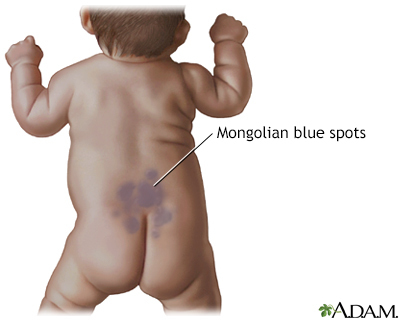Mongolian blue spots
Definition
Dermal melanocytosis is the name of a kind of birthmark that is flat, blue, or blue-gray. They appear at birth or in the first few weeks of life. Dermal melanocytosis was formerly called Mongolian blue spots.
Alternative Names
Mongolian spots; Congenital dermal melanocytosis
Causes
Dermal melanocytosis is common among people of Asian, Native American, Hispanic, East Indian, and African descent.
The color of the birth mark is from a collection of melanocytes in the deeper layers of the skin. Melanocytes are cells that make the pigment (color) in the skin.
Symptoms
Dermal melanocytosis is not cancerous and are not associated with disease. The markings may cover a large area of the back.
The markings are usually:
- Blue or blue-gray spots on the back, buttocks, base of spine, shoulders, or other body areas
- Flat with irregular shape and unclear edges
- Normal in skin texture
- 2 to 8 centimeters wide or larger
Dermal melanocytosis is sometimes mistaken for bruises. This can raise a question about possible child abuse. It is important to recognize that dermal melanocytosis is a birthmark, not bruises.
Exams and Tests
No tests are needed. The health care provider can diagnose this condition by looking at the skin.
If the provider suspects an underlying disorder, further tests will be done.
Treatment
No treatment is needed when dermal melanocytosis is a normal birthmark. If treatment is needed, lasers may be used.
Spots may be a sign of an underlying disorder. If so, treatment for that problem will likely be recommended. Your provider can tell you more.
Outlook (Prognosis)
Spots that are normal birthmarks often fade in a few years. They are almost always gone by the teen years.
When to Contact a Medical Professional
All birthmarks should be examined by a provider during the routine newborn examination.
Gallery


References
DiBiagio JR Lloyd MC, Dermatology. In: Kleinman K, Mcdaniel L, Molloy M, eds. Harriet Lane Handbook. 22nd ed. Philadelphia, PA: Elsevier; 2021:chap 8.
James WD, Elston DM, Treat JR, Rosenbach MA, Neuhaus IM. Melanocytic nevi and neoplasms. In: James WD, Elston DM, Treat JR, Rosenbach MA, Neuhaus IM, eds. Andrews' Diseases of the Skin: Clinical Dermatology. 13th ed. Philadelphia, PA: Elsevier; 2020:chap 30.
McClean ME, Martin KL. Cutaneous nevi. In: Kliegman RM, St. Geme JW, Blum NJ, Shah SS, Tasker RC, Wilson KM, eds. Nelson Textbook of Pediatrics. 21st ed. Philadelphia, PA: Elsevier; 2020:chap 670.